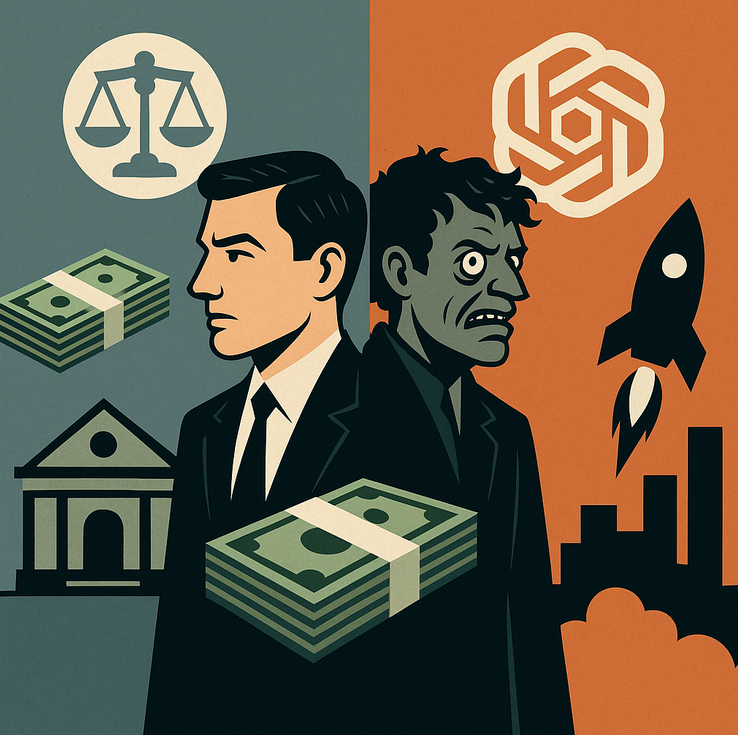THE JEKYLL & HYDE AI TECH STRATEGY
(MSFT), (GOOGL)
You know what's more complicated than explaining blockchain to your grandmother? Keeping up with OpenAI's corporate structure.
Just when I thought I had a handle on their business model (scribbled on the back of a cocktail napkin during a particularly illuminating earnings call), Sam Altman and his crew decided to reshuffle the deck.
OpenAI just pulled off what I'm calling the "nonprofit boomerang" – tossing aside plans to become fully for-profit and instead embracing a hybrid structure where their nonprofit entity remains in charge. At $300 billion valuation, that's one expensive boomerang!
This new hybrid structure creates a fascinating tension. It’s pretty much like trying to drive a Ferrari while simultaneously pledging to use it primarily for charity work.
For those of us with skin in the AI game (and if you're reading this, I assume you're not still investing exclusively in rotary phone manufacturers), this forces a fundamental question: are we betting on companies that can quickly maximize quarterly returns, or those positioned for sustainable leadership in what might be humanity's most transformative technology since fire? (Okay, maybe the wheel too, but you get my point.)
Let's talk about the elephant (or should I say, window?) in the room: Microsoft (MSFT).
With billions invested in OpenAI, Redmond execs must be having interesting conversations about how this governance shift affects their investment.
Back in 2019, I actually relocated my portfolio to give Microsoft a heftier allocation precisely because of their OpenAI partnership – a decision that paid handsome dividends as their stock climbed.
The market's relatively muted reaction to OpenAI's latest twist suggests investors are taking a "wait and see" approach, which in investor-speak means "panicking quietly while maintaining a neutral facial expression."
My take? Microsoft's diverse portfolio provides insulation from OpenAI governance surprises, while still giving them prime access to cutting-edge AI.
They're essentially wearing a safety harness while rock climbing alongside a partner who might suddenly decide halfway up the cliff that they're now spiritually opposed to carabiners.
This governance seesaw creates ripple effects across the entire AI ecosystem so profound that even my normally tech-oblivious neighbor asked me about it between complaints about my unmowed lawn.
And last week at a dinner party, I watched several tech VCs nearly come to blows over OpenAI's structure.
"It's brilliant camouflage," one argued between bites of overpriced sushi. "They get to look responsible while still chasing unicorn valuations."
Another countered that the structure genuinely changes incentives, potentially slowing development but creating more sustainable long-term value than a well-diversified retirement portfolio.
Both perspectives directly influence where smart money flows in the AI sector – and where my own investment dollars are headed next quarter.
The timeline question becomes more critical for your investment approach than deciding when to leave for the airport (hint: earlier than you think).
Short-term players looking 1-2 years out should focus on companies monetizing existing AI capabilities – those turning the current generation of models into revenue streams faster than politicians turn scandals into fundraising opportunities.
For long-haul investors with 5+ year horizons, OpenAI's move suggests prioritizing companies with both substantial R&D investments and ethical frameworks for deployment more robust than my New Year's resolutions.
The days of "move fast and break things" may be yielding to "move thoughtfully and build lasting value" – at least in this corner of the tech universe, which frankly is refreshing in an era where most things are designed to last about as long as unrefrigerated seafood.
OpenAI's conversion to a public benefit corporation rather than remaining an LLC adds another fascinating wrinkle.
I recently shared an elevator with a corporate governance expert who called benefit corporations "the mullets of business structures – profit in the front, social responsibility in the back." But watching a $300 billion company embrace this model suggests we're witnessing a genuine shift.
For our portfolio, this means evaluating not just quarterly performance but the alignment between profit motives and ethical considerations.
My investment approach has evolved accordingly. I've built an AI portfolio resembling a well-balanced meal rather than just loading up on sugar.
The protein comes from established tech giants with significant AI investments – your Microsofts and Alphabets (GOOGL).
The complex carbs are specialized AI implementers actually generating revenue today, like Salesforce (CRM) and Nvidia (NVDA).
The vegetables (yes, eat your vegetables) are emerging innovators with strong ethical frameworks like C3.ai (AI), which has built responsible principles into its foundation, or LivePerson (LPSN) with its ethical approach to customer service AI.
And for dessert? A small slice of speculative moonshots like BigBear.ai (BBAI) or SoundHound AI (SOUN) because sometimes revolutionary returns come from unexpected places.
Last month, this philosophy led me to trim a position in a high-flying but ethically questionable AI startup that had tripled my initial investment.
Was walking away from potential gains painful? Like giving up the last slice of pizza.
But in the AI sector, today's ethical shortcuts often become tomorrow's regulatory nightmares or reputational disasters – a lesson I learned the hard way after an ill-advised investment in a facial recognition company that shall remain nameless (though their legal team certainly knows my name).

